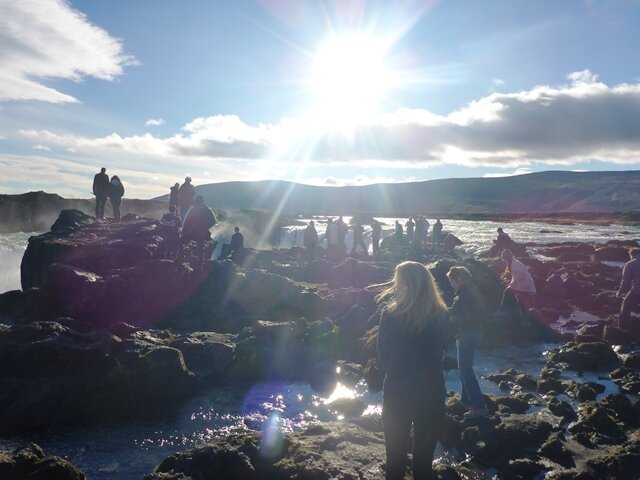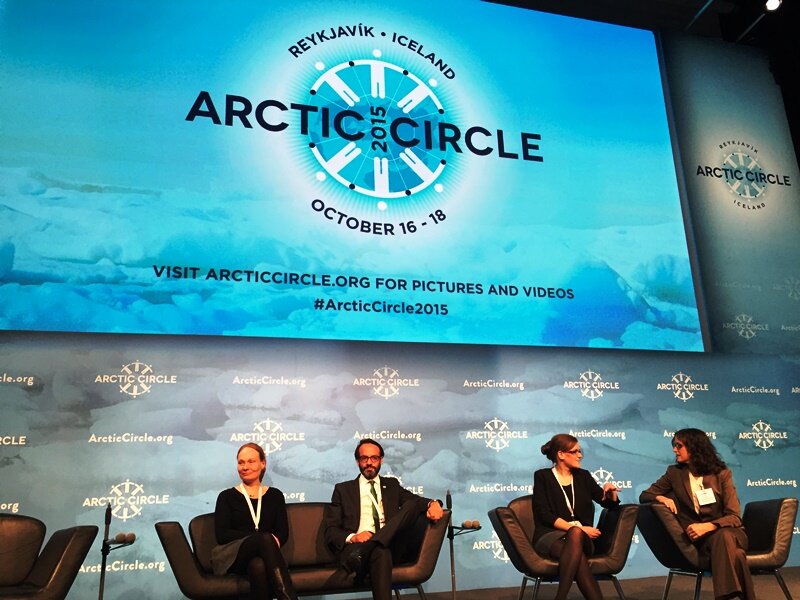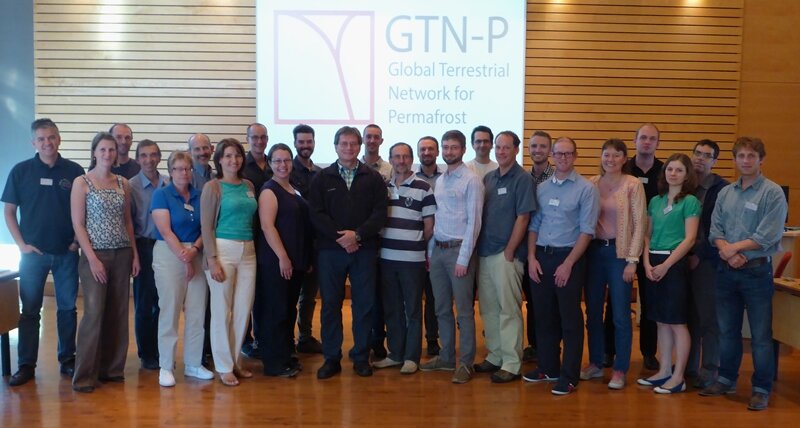GTN - P Database now launched
- Details
- Created on Monday, 05 May 2014 10:10
 Permafrost is a direct indicator of climate change and has been identified as Essential Climate Variable (ECV) by the global observing community. The monitoring of permafrost temperatures, active-layer thicknesses and other parameters has been performed for several decades already, but it was brought together within the Global Terrestrial Network for Permafrost (GTN-P) in the 1990's only, including the development of measurement protocols to provide standardized data.
Permafrost is a direct indicator of climate change and has been identified as Essential Climate Variable (ECV) by the global observing community. The monitoring of permafrost temperatures, active-layer thicknesses and other parameters has been performed for several decades already, but it was brought together within the Global Terrestrial Network for Permafrost (GTN-P) in the 1990's only, including the development of measurement protocols to provide standardized data.
GTN-P is the primary international observing network for permafrost sponsored by the Global Climate Observing System (GCOS) and the Global Terrestrial Observing System (GTOS), and managed by the International Permafrost Association (IPA). All GTN-P data was outfitted with an "open data policy" with free data access via the World Wide Web.
The existing data, however, is far from being homogeneous: it is not yet optimized for databases, there is no framework for data reporting or archival and data documentation is incomplete. As a result, and despite the utmost relevance of permafrost in the Earth's climate system, the data has not been used by as many researchers as intended by the initiators of the programs. While the monitoring of many other ECVs has been tackled by organized international networks (e.g. FLUXNET), there is still no central database for all permafrost-related parameters.
The European Union project PAGE21 created opportunities to develop this central database for permafrost monitoring parameters of GTN-P during the duration of the project and beyond. The database aims to be the one location where the researcher can find data, metadata, and information of all relevant parameters for a specific site. Each component of the Data Management System (DMS), including parameters, data levels and metadata formats were developed in cooperation with the GTN-P and the IPA.
The general framework of the GTN-P DMS is based on an object oriented model (OOM), open for as many parameters as possible, and implemented into a spatial database. To ensure interoperability and enable potential inter-database search, field names are following international metadata standards and are based on a control vocabulary registry. Tools are developed to provide data processing, analysis capability, and quality control. Our system aims to be a reference model, improvable and reusable. It allows a maximum top-down and bottom-up data flow, giving scientists one global searchable data and metadata repository, the public a full access to scientific data, and the policy maker a powerful cartographic and statistical tool.
To engage the international community in GTN-P, it was essential to develop an online interface for data upload. Aim for this was that it is easy-to-use and allows data input with a minimum of technical and personal effort. In addition to this, large efforts will have to be produced in order to be able to query, visualize and retrieve information over many platforms and type of measurements. Ultimately, it is not the layer in itself that matter, but more the relationship that these information layers maintain with each other.
Click here to access the GTN - P Database
Cherskii 2014: Travelling to the site
- Details
- Created on Tuesday, 15 April 2014 13:23
 Before I will start my second blog considering the traveling to Siberia, which can be special, I want to use the opportunity to inform you that our group is also involved into another project called CarboPerm (http://carboperm.de), which focus on carbon in permafrost.
Before I will start my second blog considering the traveling to Siberia, which can be special, I want to use the opportunity to inform you that our group is also involved into another project called CarboPerm (http://carboperm.de), which focus on carbon in permafrost.
It is similar to PAGE21 but is funded not by the EU but as a bilateral project of Russia and Germany. For this project I am also writing a blog, so do not be confused if you find similar information there.
Traveling to Cherskii is always an adventure. Not just the traveling itself but also the preparation beforehand, the trip itself and the spots you can visit in-between.
Last year we had some shipping problems with our equipment and had to postpone our trip to Cherskii for approximately one week. But this year everything worked well and the boxes with the equipment were there in time.
 Due to a relatively small total amount of equipment we had to ship to Cherskii this year, the preparation before the trip was not too long. But there was one special thing to do: Get some equipment, especially clothing, with is capable to withstand extreme weather conditions and protect us from freezing during field trips with very low temperatures.
Due to a relatively small total amount of equipment we had to ship to Cherskii this year, the preparation before the trip was not too long. But there was one special thing to do: Get some equipment, especially clothing, with is capable to withstand extreme weather conditions and protect us from freezing during field trips with very low temperatures.
Luckily the Alfred-Wegener Institute (http://www.awi.de/de/), one of our partners within the project, has a big storage with all kinds of special equipment, where we borrowed a lot of useful things. Thanks for that again, it is very helpful now and I cannot, or better will not, imagine how it would be without these.
During the trip itself we had the chance to visit the city of Yakutsk. The last times when somebody from our team was traveling to Cherskii it was one long but continuously trip, i.e. without the need for stopovers.
 This time, we were not able to do this because they changed the flight plans and we had to stay overnight in Yakutsk, but this was a nice opportunity to explore the "coldest-city" as it is often called.
This time, we were not able to do this because they changed the flight plans and we had to stay overnight in Yakutsk, but this was a nice opportunity to explore the "coldest-city" as it is often called.
Yakutsk is the capital of the Sakha Republic and inhabits nearly 300.000 citizens. If you visit the city it is like to be in two different worlds. There are modern and fancy glass-buildings next to traditional wooden houses.
In Yakutsk we walked around the city center, tried traditional pastry and visited the mammoth museum. In total it was a highly interesting day and I can just recommend visiting the city if you have a chance.
Fieldwork in the Arctic and Subarctic: exhibition
- Details
- Created on Friday, 11 April 2014 10:54
When: Monday April, 28th 7 p.m.
Department of Social and Cultural Anthropology
NIG – Neues Institutsgebäude, 4th floor
Universitätsstr. 7
1010 Vienna
NIG – Neues Institutsgebäude, 4th floor
Universitätsstr. 7
1010 Vienna
Opening talks:
Univ. Prof. Dr. Peter Schweitzer (Department of Social and Cultural Anthropology, Univ. of Vienna, Austrian Polar Research Institute)
Univ. Prof. Dr. Andreas Richter (Department of Department of Terrestrial Ecosystem Research, Univ. of Vienna, Austrian Polar Research Institute)
Mag. Sigrid Schiesser (Department of Social and Cultural Anthropology, Univ. of Vienna, APECS Austria)
Univ. Prof. Dr. Andreas Richter (Department of Department of Terrestrial Ecosystem Research, Univ. of Vienna, Austrian Polar Research Institute)
Mag. Sigrid Schiesser (Department of Social and Cultural Anthropology, Univ. of Vienna, APECS Austria)
On April 28th, we celebrate the foundation of APECS Austria, which is part of the international and interdisciplinary Association of Polar Early Career Scientists (APECS).
APECS provides a platform for interdisciplinary networking and exchange of researchers working in Arctic and Subarctic regions.
The photo and poster exhibition "Fieldwork in the Arctic and Subarctic" shows the diversity of Arctic and Subarctic environments, and gives insights into daily lives of residents and researchers. The photographs of the exhibition illustrate the context of research in Polar regions beyond conventional formats of texts, tables and numbers.
The exhibition will be open on workdays from April 28th until May 16th.
Click here for more information about the exhibition.
European Geosciences Union General Assembly coming soon
- Details
- Created on Thursday, 03 April 2014 15:15
The EGU General Assembly 2014 will bring together geoscientists from all over the world to one meeting covering all disciplines of the Earth, planetary and space sciences.
The EGU aims to provide a forum where scientists, especially early career researchers, can present their work and discuss their ideas with experts in all fields of geosciences. For the first time, in 2014, the EGU General Assembly will have a theme!
Like a human face, our planet exhibits a large diversity of intricate shapes and patterns. In the dynamic Earth system, processes continuously create, modify and destroy specific forms while, at the same time, individual forms and larger patterns constrain how processes operate.
The Face of the Earth theme intends to celebrate the diversity of geoscience processes and the great variety of associated forms, across all scales and from the core of the Earth to interplanetary space. This diversity is reflected in the five subtopics of the 2014 meeting: Rocks of the Earth, Waters of the Earth, Life of the Earth, Atmosphere of the Earth, and Space and the Earth.
The APECS – Austria Kick – off evening will take place on Monday, 28th of April at 7 p.m
Opening talks will be made by Univ. Prof. Dr. Peter Schweitzer (Department of Social and Cultural Anthropology, Univ. of Vienna, Austrian Polar Research Institute), Univ.
Prof. Dr. Andreas Richter (Department of Department of Terrestrial Ecosystem Research, Univ. of Vienna, Austrian Polar Research Institute), Mag. Sigrid Schiesser (Department of Social and Cultural Anthropology, Univ. of Vienna, APECS Austria).
On April 28th, the organizers will celebrate the foundation of APECS Austria, which is part of the international and interdisciplinary Association of Polar Early Career Scientists (APECS).
Click here to register for the event. For more information about the event, click the button on the top right cornet on the homepage.
IASC Bulletin 2014 is now available
- Details
- Created on Tuesday, 01 April 2014 11:19
Each year IASC reports on its activities and highlights international Arctic science initiatives in its Bulletin. The 2014 Bulletin is now available for download on the IASC website.
A printed copy will be available on the ASSW 2014 in Helsinki, Finland.
The International Arctic Science Committee (IASC) is a non-governmental, international scientific organization.
The IASC mission is to encourage and facilitate cooperation in all aspects of Arctic research, in all countries engaged in Arctic research and in all areas of the Arctic region.
Overall, IASC promotes and supports leading-edge multidisciplinary research in order to foster a greater scientific understanding of the Arctic region and its role in the Earth system.
For a digital copy, please visit the service section of IASC website under http://www.iasc.info/images/service/Bulletin2014.pdf








